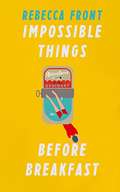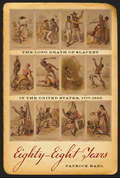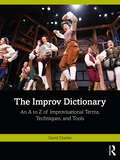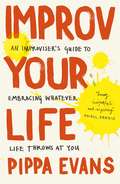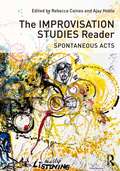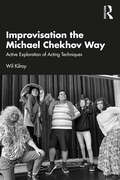- Table View
- List View
Impossible Bodies: Femininity and Masculinity at the Movies (Comedia)
by Christine HolmlundImpossible Bodies investigates issues of ethnicity, gender, and sexuality in contemporary Hollywood. Examining stars from Arnold Schwarzenegger and Clint Eastwood, to Whoopi Goldberg and Jennifer Lopez, Holmlund focuses on actors whose physique or appearance marks them as unusual or exceptional, and yet who occupy key and revealing positions in today's mainstream cinema. Exploring a range of genres and considering both stars and their sidekicks, Holmlund examines ways in which Hollywood accommodates - or doesn't - a variety of 'impossible' bodies, from the 'outrageous' physiques of Dolph Lundgren and Dolly Parton, to the almost-invisible bodies of Asian-Americans, Latinas and older actors.
Impossible Puzzle Films: A Cognitive Approach to Contemporary Complex Cinema
by Miklós Kiss Steven WillemsenNarrative complexity is a trend in contemporary cinema. Since the late 1990s there has been a palpable increase in complex storytelling in movies. But how and why do complex movies create perplexity and confusion? How do we engage with these challenges? And what makes complex stories so attractive? By blending film studies, narrative theory and cognitive sciences, Kiss and Wilemsen look into the relation between complex storytelling and the mind. Analysing the effects that different complex narratives have on viewers, the book addresses how films like Donnie Darko, Mulholland Drive and Primer strategically create complexity and confusion, using the specific category of the impossible puzzle film to examine movies that use baffling paradoxes, impossible loops, and unresolved ambiguities in their stories and storytelling. By looking at how these films play on our mind’s blind spots, this innovative book explains their viewing effects in terms of the mental state of cognitive dissonance that they evoke.
Impossible Puzzle Films: A Cognitive Approach to Contemporary Complex Cinema (Edinburgh University Press)
by Miklós Kiss Steven WillemsenNarrative complexity is a trend in contemporary cinema. Since the late 1990s there has been a palpable increase in complex storytelling in movies. But how and why do complex movies create perplexity and confusion? How do we engage with these challenges? And what makes complex stories so attractive? By blending film studies, narrative theory and cognitive sciences, Kiss and Wilemsen look into the relation between complex storytelling and the mind. Analysing the effects that different complex narratives have on viewers, the book addresses how films like Donnie Darko, Mulholland Drive and Primer strategically create complexity and confusion, using the specific category of the impossible puzzle film to examine movies that use baffling paradoxes, impossible loops, and unresolved ambiguities in their stories and storytelling. By looking at how these films play on our mind’s blind spots, this innovative book explains their viewing effects in terms of the mental state of cognitive dissonance that they evoke.
Impossible Things Before Breakfast: Adventures in the Ordinary
by Rebecca Front'Hilarious' Daily Mail'I was completely captivated' David SedarisPeople are odd. Even the most predictable of us sometimes defy expectations. Add to that the tricks that life plays on us and the world suddenly seems full of impossible things.As an award-winning actor and writer, Rebecca Front has always been fascinated by life's little quirks. Impossible Things Before Breakfast is a collection of true stories about surprising turns of events, bizarre misunderstandings and improbable life lessons. We learn, among other things, how gazing at the stars can help you communicate with teenagers, how a mushroom can undermine an ancient ritual, and why everyone should wear a cape.Combining elegant writing, wry humour and genuine insight, this brilliant collection prises open the lid on ordinary life and feasts on the impossible.
Impro: Improvisation and the Theatre (Performance Books)
by Keith JohnstoneA leading figure in the theatre, Keith Johnstone lays bare his techniques and exercises to foster spontaneity and narrative skill for actors. These techniques and exercises were evolved in the actors' studio, when he was Associate Director of the Royal Court and then in demonstrations to schools and colleges and ultimately in the founding of a company of performers called The Theatre Machine. Divided into four sections, "Status", "Spontaneity", "Narrative Skills" and "Masks and Trance", arranged more or less in the order a group might approach them, the book sets out the specific approaches which Johnstone has himself found most useful and most stimulating. The result is a fascinating exploration of the nature of spontaneous creativity. "If teachers were honoured in the British theatre along-side directors, designers and playwrights, Keith Johnstone would be as familiar a name as are those of . . . Jocelyn Herbert, Edward Bond and other young talents who were drawn to the great lodestone of the Royal Court Theatre in the late 1950s. As head of the script department, Johnstone played a crucial part in the development of the 'writers' theatre . . . " Irving Wardle
Impro: Improvisation and the Theatre (Bloomsbury Revelations)
by Keith JohnstoneIn this landmark work Keith Johnstone provides a revelatory guide to rediscovering and unlocking the imagination. Admired for its clarity and zest, Impro lays bare the techniques and exercises used to foster spontaneity and narrative skill for actors. These techniques and exercises were evolved in the actors' studio, when he was Associate Director of the Royal Court and then in demonstrations to schools and colleges and ultimately in the founding of a company of performers called The Theatre Machine. Divided into four sections, 'Status', 'Spontaneity', 'Narrative Skills' and 'Masks and Trance', arranged more or less in the order a group might approach them, the book sets out the specific approaches which Johnstone has himself found most useful and most stimulating. The result is a fascinating exploration of the nature of spontaneous creativity. 'If teachers were honoured in the British theatre along-side directors, designers and playwrights, Keith Johnstone would be as familiar a name as are those of . . . Jocelyn Herbert, Edward Bond and other young talents who were drawn to the great lodestone of the Royal Court Theatre in the late 1950s. As head of the script department, Johnstone played a crucial part in the development of the 'writers' theatre.' Irving Wardle
Impro: Improvisation and the Theatre (Performance Books)
by Keith JohnstoneA leading figure in the theatre, Keith Johnstone lays bare his techniques and exercises to foster spontaneity and narrative skill for actors. These techniques and exercises were evolved in the actors' studio, when he was Associate Director of the Royal Court and then in demonstrations to schools and colleges and ultimately in the founding of a company of performers called The Theatre Machine. Divided into four sections, "Status", "Spontaneity", "Narrative Skills" and "Masks and Trance", arranged more or less in the order a group might approach them, the book sets out the specific approaches which Johnstone has himself found most useful and most stimulating. The result is a fascinating exploration of the nature of spontaneous creativity. "If teachers were honoured in the British theatre along-side directors, designers and playwrights, Keith Johnstone would be as familiar a name as are those of . . . Jocelyn Herbert, Edward Bond and other young talents who were drawn to the great lodestone of the Royal Court Theatre in the late 1950s. As head of the script department, Johnstone played a crucial part in the development of the 'writers' theatre . . . " Irving Wardle
Impro: Improvisation and the Theatre (Bloomsbury Revelations)
by Keith JohnstoneIn this landmark work Keith Johnstone provides a revelatory guide to rediscovering and unlocking the imagination. Admired for its clarity and zest, Impro lays bare the techniques and exercises used to foster spontaneity and narrative skill for actors. These techniques and exercises were evolved in the actors' studio, when he was Associate Director of the Royal Court and then in demonstrations to schools and colleges and ultimately in the founding of a company of performers called The Theatre Machine. Divided into four sections, 'Status', 'Spontaneity', 'Narrative Skills' and 'Masks and Trance', arranged more or less in the order a group might approach them, the book sets out the specific approaches which Johnstone has himself found most useful and most stimulating. The result is a fascinating exploration of the nature of spontaneous creativity. 'If teachers were honoured in the British theatre along-side directors, designers and playwrights, Keith Johnstone would be as familiar a name as are those of . . . Jocelyn Herbert, Edward Bond and other young talents who were drawn to the great lodestone of the Royal Court Theatre in the late 1950s. As head of the script department, Johnstone played a crucial part in the development of the 'writers' theatre.' Irving Wardle
IMPRO Improvisation and the Theatre: Improvisation And The Theatre (Bloomsbury Revelations Ser.)
by Keith JohnstoneA leading figure in the theatre, Keith Johnstone lays bare his techniques and exercises to foster spontaneity and narrative skill for actors. These techniques and exercises were evolved in the actors' studio, when he was Associate Director of the Royal Court and then in demonstrations to schools and colleges and ultimately in the founding of a company of performers called The Theatre Machine. Divided into four sections, "Status", "Spontaneity", "Narrative Skills" and "Masks and Trance", arranged more or less in the order a group might approach them, the book sets out the specific approaches which Johnstone has himself found most useful and most stimulating. The result is a fascinating exploration of the nature of spontaneous creativity. "If teachers were honoured in the British theatre along-side directors, designers and playwrights, Keith Johnstone would be as familiar a name as are those of . . . Jocelyn Herbert, Edward Bond and other young talents who were drawn to the great lodestone of the Royal Court Theatre in the late 1950s. As head of the script department, Johnstone played a crucial part in the development of the 'writers' theatre . . . " Irving Wardle
The Improbable Adventures of Miss Emily Soldene: Actress, Writer, and Rebel Victorian
by Helen Batten'I rode on the stage in such style, that the men in front forgot I was a girl, and also forgot to laugh.'From humble beginnings as the daughter of a Clerkenwell milliner, Emily Soldene rose to become a leading lady of the London stage and a formidable impresario with her own opera company. The darling of London's theatreland, she later reinvented herself as a journalist and writer who scandalised the capital with her backstage revelations.Weaving through the spurious glamour of Victorian music halls and theatres, taking encounters with the Pre-Raphaelites and legal disputes involving Charles Dickens in her stride, Emily became the toast of New York and ventured far off the beaten track to tour in Australia and New Zealand. In The Improbable Adventures of Miss Emily Soldene, a life filled with performance, travel and incident returns to centre stage.
The Improv Dictionary: An A to Z of Improvisational Terms, Techniques, and Tools
by David CharlesThe Improv Dictionary: An A to Z of Improvisational Terms, Techniques, and Tools explores improvisational approaches and concepts drawn from a multitude of movements and schools of thought to enhance spontaneous and collaborative creativity.This accessible resource reveals and interrogates the inherited wisdoms contained in the very words we use to describe modern improv. Each detailed definition goes beyond the obvious clichés and seeks a nuanced and inclusive understanding of how art of the moment can be much more than easy laughs and cheap gags (even when it is being delightfully irreverent and wildly funny). This encyclopedic work pulls from a wide array of practitioners and practices, finding tensions and commonalities from styles as diverse as Theatresports, Comedysportz, the Harold, narrative long-form, Playback Theatre, and Boal’s Theatre of the Oppressed. Entries include nuanced definitions, helpful examples, detailed explorations of the concepts in practice, and framing quotes from a leading practitioner or inspirational artistic voice.The Improv Dictionary offers valuable insights to novice improvisers taking their first steps in the craft, seasoned performers seeking to unlock the next level of abandon, instructors craving a new comprehensive resource, and scholars working in one of the numerous allied fields that find enrichment through collaborative and guided play.Each significant entry in the book is also keyed to an accompanying improv game or exercise housed at www.improvdr.com, enabling readers to dig deeper into their process.
The Improv Dictionary: An A to Z of Improvisational Terms, Techniques, and Tools
by David CharlesThe Improv Dictionary: An A to Z of Improvisational Terms, Techniques, and Tools explores improvisational approaches and concepts drawn from a multitude of movements and schools of thought to enhance spontaneous and collaborative creativity.This accessible resource reveals and interrogates the inherited wisdoms contained in the very words we use to describe modern improv. Each detailed definition goes beyond the obvious clichés and seeks a nuanced and inclusive understanding of how art of the moment can be much more than easy laughs and cheap gags (even when it is being delightfully irreverent and wildly funny). This encyclopedic work pulls from a wide array of practitioners and practices, finding tensions and commonalities from styles as diverse as Theatresports, Comedysportz, the Harold, narrative long-form, Playback Theatre, and Boal’s Theatre of the Oppressed. Entries include nuanced definitions, helpful examples, detailed explorations of the concepts in practice, and framing quotes from a leading practitioner or inspirational artistic voice.The Improv Dictionary offers valuable insights to novice improvisers taking their first steps in the craft, seasoned performers seeking to unlock the next level of abandon, instructors craving a new comprehensive resource, and scholars working in one of the numerous allied fields that find enrichment through collaborative and guided play.Each significant entry in the book is also keyed to an accompanying improv game or exercise housed at www.improvdr.com, enabling readers to dig deeper into their process.
The Improv Handbook: The Ultimate Guide to Improvising in Comedy, Theatre, and Beyond (Performance Books)
by Tom Salinsky Deborah Frances-WhiteThe Improv Handbook is the most comprehensive, smart, helpful and inspiring guide to improv available today. Applicable to comedians, actors, public speakers and anyone who needs to think on their toes, it features a range of games, interviews, descriptions and exercises that illuminate and illustrate the exciting world of improvised performance.First published in 2008, this second edition features a new foreword by comedian Mike McShane, as well as new exercises on endings, managing blind offers and master-servant games, plus new and expanded interviews with Keith Johnstone, Neil Mullarkey, Jeffrey Sweet and Paul Rogan. The Improv Handbook is a one-stop guide to the exciting world of improvisation. Whether you're a beginner, an expert, or would just love to try it if you weren't too scared, The Improv Handbook will guide you every step of the way.
The Improv Handbook: The Ultimate Guide to Improvising in Comedy, Theatre, and Beyond
by Tom Salinsky Deborah Frances-WhiteThe most comprehensive, smart, helpful and inspiring guide to improve available today. Applicable to comedians, actors, public speakers and anyone who needs to think on their toes.From The Improv Handbook: The problem for improvisers is anxiety. faced with a lot of nameless eyes staring at us, and feeling more than anything else like prey, we are likely to want to display very consistent behavior, so that anyone who looks at us, looks away and then looks back sees the same thing. Thus we become boring, we fade into the background, and we cease to be of interest. The Improv Handbook provides everything someone interested in improvisational comedy needs to know, as written by a husband and wife comedy duo with years of experience and teaching in the field. in addition to providing a comprehensive history of improvisational theater as a backdrop, it also looks at modern theories and practices of improvisation on a global scale, including how the form of comedy has evolved differently in different parts of the world, from Europe to the UK to the Chicago scene. The Improv Handbook also contains an essential performance segment that details different formats of improvisation. Chapter topics include Theatresports, Micetro, Gorilla Theatre, and the inventions of Keith Johnstone and Del Close as well as other popular forms of improv, like those on "Whose Line is it Anyway." The core section of the book is called simply, "How to Improvise" and delves into issues of spontaneity, the fundamentals of storytelling, working together, upping the ante, and character development. The book concludes with sections on how to improvise in front of an audience and- just as crucially- how to attract an audience in the first place.
The Improv Handbook: The Ultimate Guide to Improvising in Comedy, Theatre, and Beyond (Performance Books)
by Tom Salinsky Deborah Frances-WhiteThe Improv Handbook is the most comprehensive, smart, helpful and inspiring guide to improv available today. Applicable to comedians, actors, public speakers and anyone who needs to think on their toes, it features a range of games, interviews, descriptions and exercises that illuminate and illustrate the exciting world of improvised performance.First published in 2008, this second edition features a new foreword by comedian Mike McShane, as well as new exercises on endings, managing blind offers and master-servant games, plus new and expanded interviews with Keith Johnstone, Neil Mullarkey, Jeffrey Sweet and Paul Rogan. The Improv Handbook is a one-stop guide to the exciting world of improvisation. Whether you're a beginner, an expert, or would just love to try it if you weren't too scared, The Improv Handbook will guide you every step of the way.
The Improv Illusionist: Using Object Work, Environment, and Physicality in Performance
by David RaittObject work, environment and physicality are essential for improvisational theatre. Skilled improvisers can draw audiences into the performance by helping them see things that aren't there.The Improv Illusionist is the first book dedicated to physical improv. It reveals why these skills are so important, how to fix bad habits that develop over time and practical techniques for being more physical on stage.The book features over 50 exercises to help improvisers develop their skills through solo and group work. Instructors will also find notes and tips for teaching physical improv.Improvisers of all ages and experience levels will learn how to: * become more playful through exploring physical activity; * eliminate miscommunication with other players by adding precision to object work; * get new ideas for scenes by exploring the environment and activities; * develop an eye for real-world detail and how to reproduce it in improv; * add more visual flair to scenes; * stay safe, both physically and emotionally, in shows, rehearsals and classesEven the most seasoned improv performers often struggle to be more physical, so this book fills an important niche in improv actor training.
The Improv Illusionist: Using Object Work, Environment, and Physicality in Performance
by David RaittObject work, environment and physicality are essential for improvisational theatre. Skilled improvisers can draw audiences into the performance by helping them see things that aren't there.The Improv Illusionist is the first book dedicated to physical improv. It reveals why these skills are so important, how to fix bad habits that develop over time and practical techniques for being more physical on stage.The book features over 50 exercises to help improvisers develop their skills through solo and group work. Instructors will also find notes and tips for teaching physical improv.Improvisers of all ages and experience levels will learn how to: * become more playful through exploring physical activity; * eliminate miscommunication with other players by adding precision to object work; * get new ideas for scenes by exploring the environment and activities; * develop an eye for real-world detail and how to reproduce it in improv; * add more visual flair to scenes; * stay safe, both physically and emotionally, in shows, rehearsals and classesEven the most seasoned improv performers often struggle to be more physical, so this book fills an important niche in improv actor training.
Improv Your Life
by Pippa Evans'If you want to be more present, more reactive and have more fun - this book is for you' SARA PASCOE'Funny, insightful and inspiring' RACHEL PARRIS'Essential reading for anyone wanting to do life, but better' CARIAD LLOYD'A wonderfully witty, charmingly personal guide to the art of improvisation for the stage & life' DEBORAH FRANCES WHITEAn improviser's guide to embracing whatever life throws at you!PIPPA EVANS is an expert in saying Yes - and No. She's a master of thinking on her feet, but has also had to learn how to go with the flow. In this book she's passing on everything she's learnt from her award winning improv career, as both a performer and teacher, so YOU can take centre stage in your own life.In telling her story, delving into the craft of improvisation, and sharing fun exercises and practice you can do at home, Pippa will help you become fully yourself - realising your potential and ability to adapt to the ever changing world around you. It's dangerous, being yourself, but let's just take it one step at a time. Open the book, take a breath and get ready to say YES. (If it's a NO from you then perhaps consider buying for a friend, family member or enemy who you think needs some improv-ment)
Improvisation in Drama, Theatre and Performance: History, Practice, Theory
by Anthony Frost Ralph YarrowImprovisation is a tool for many things: performance training, rehearsal practice, playwriting, therapeutic interaction and somatic discovery. This book opens up the significance of improvisation across cultures, histories and ways of performing our life, offering key insights into the what, the how and the why of performance. It traces the origins of improvisation and its influences, both as a social and political phenomenon and its position in performance training. Including history, theory and practice, this new edition encompasses Theatre and Performance Studies as well as Drama, acknowledging the rapid reconfiguration of these fields in recent years. Its coverage also now extends to improvisation in the USA, cinema, LARPing, street events and the improvising audience, while also looking at improv's relationship to stand-up comedy, jazz, poetry and free movement practices. With an index of exercises and an extensive bibliography, this book is indispensable to students of improvisation.
Improvisation in Drama, Theatre and Performance: History, Practice, Theory
by Anthony Frost Ralph YarrowImprovisation is a tool for many things: performance training, rehearsal practice, playwriting, therapeutic interaction and somatic discovery. This book opens up the significance of improvisation across cultures, histories and ways of performing our life, offering key insights into the what, the how and the why of performance. It traces the origins of improvisation and its influences, both as a social and political phenomenon and its position in performance training. Including history, theory and practice, this new edition encompasses Theatre and performance studies as well as drama, acknowledging the rapid reconfiguration of these fields in recent years. Its coverage also now extends to improvisation in the USA, cinema, LARPing, street events and the improvising audience, while also looking at improv's relationship to stand-up comedy, jazz, poetry and free movement practices. With an index of exercises and an extensive bibliography, this book is indispensable to students of improvisation.
Improvisation in the Expressive and Performing Arts: eBook
by Beliz DemirciogluDrawing on the experiences of individuals in the expressive and performing arts, this book examines how we experience improvisation and the interaction of intellect and intuition within it. It reveals how the approach and methods of expressive arts can enrich improvisation and spur the desire for discovery.
The Improvisation Studies Reader: Spontaneous Acts
by Ajay Heble Rebecca CainesImprovisation is a performance practice that animates and activates diverse energies of inspiration, critique, and invention. In recent years it has coalesced into an exciting and innovative new field of interdisciplinary scholarly inquiry, becoming a cornerstone of both practical and theoretical approaches to performance. The Improvisation Studies Reader draws together the works of key artists and thinkers from a range of disciplines, including theatre, music, literature, film, and dance. Divided by keywords into eight sections, this book bridges the gaps between these fields. The book includes case studies, exercises, graphic scores and poems in order to produce a teaching and research resource that identifies central themes in improvisation studies. The sections include: Listening Trust/Risk Flow Dissonance Responsibility Liveness Surprise Hope Each section of the Reader is introduced by a newly commissioned think piece by a key figure in the field, which opens up research questions reflecting on the keyword in question. By placing key theoretical and classic texts in conversation with cutting-edge research and artists’ statements, this book answers the urgent questions facing improvising artists and theorists in the mediatized Twenty-First Century.
The Improvisation Studies Reader: Spontaneous Acts
by Ajay Heble Rebecca CainesImprovisation is a performance practice that animates and activates diverse energies of inspiration, critique, and invention. In recent years it has coalesced into an exciting and innovative new field of interdisciplinary scholarly inquiry, becoming a cornerstone of both practical and theoretical approaches to performance. The Improvisation Studies Reader draws together the works of key artists and thinkers from a range of disciplines, including theatre, music, literature, film, and dance. Divided by keywords into eight sections, this book bridges the gaps between these fields. The book includes case studies, exercises, graphic scores and poems in order to produce a teaching and research resource that identifies central themes in improvisation studies. The sections include: Listening Trust/Risk Flow Dissonance Responsibility Liveness Surprise Hope Each section of the Reader is introduced by a newly commissioned think piece by a key figure in the field, which opens up research questions reflecting on the keyword in question. By placing key theoretical and classic texts in conversation with cutting-edge research and artists’ statements, this book answers the urgent questions facing improvising artists and theorists in the mediatized Twenty-First Century.
Improvisation the Michael Chekhov Way: Active Exploration of Acting Techniques
by Wil KilroyImprovisation the Michael Chekhov Way: Active Exploration of Acting Techniques provides readers with dozens of improvisational exercises based on the acting techniques of Michael Chekhov. The book features key exercises that will help the actor explore improvisation and expand their imagination through the technique. Exercises that have been successfully taught for decades via the intensive trainings from the National Michael Chekhov Association are now clearly laid out in this book, along with information on how these performance-based techniques can be applied to a script and even provide life benefits. Guidance on how to use the exercises both in a group setting and as an individual is provided, as well as tools for lesson plans for up to a year of actor training. These step-by-step exercises will allow readers to expand their range of expression, discover the joy of creating unique characters, improve stage presence and presentation skills, and find new, creative ways to look at life. Improvisation the Michael Chekhov Way is written to be used by individual actors and practitioners and in group settings such as acting or improvisation courses, and to benefit anyone wishing to enhance their creativity and imagination.
Improvisation the Michael Chekhov Way: Active Exploration of Acting Techniques
by Wil KilroyImprovisation the Michael Chekhov Way: Active Exploration of Acting Techniques provides readers with dozens of improvisational exercises based on the acting techniques of Michael Chekhov. The book features key exercises that will help the actor explore improvisation and expand their imagination through the technique. Exercises that have been successfully taught for decades via the intensive trainings from the National Michael Chekhov Association are now clearly laid out in this book, along with information on how these performance-based techniques can be applied to a script and even provide life benefits. Guidance on how to use the exercises both in a group setting and as an individual is provided, as well as tools for lesson plans for up to a year of actor training. These step-by-step exercises will allow readers to expand their range of expression, discover the joy of creating unique characters, improve stage presence and presentation skills, and find new, creative ways to look at life. Improvisation the Michael Chekhov Way is written to be used by individual actors and practitioners and in group settings such as acting or improvisation courses, and to benefit anyone wishing to enhance their creativity and imagination.


